You are using an out of date browser. It may not display this or other websites correctly.
You should upgrade or use an alternative browser.
You should upgrade or use an alternative browser.
-
You can now help support WorldwideDX when you shop on Amazon at no additional cost to you! Simply follow this Shop on Amazon link first and a portion of any purchase is sent to WorldwideDX to help with site costs.
SB220 on 11 meter AM. Damage control.
- Thread starter nomadradio
- Start date
I have either never heard one on AM or no one admitting too operating one there. If they're doing so without the proper modd you partially addressed in this post their obviously running them incorrectly (in the high position.) They're a beautiful looking amp. Simple totalitarian look. Very 60's looking and I guess there's a good reason for that. Always loved the look. And HK obviously had a winner. Proven by the numbers sold during it's original manufacturing run.The Heath SB220 does a fine job on AM if you read the manual and select "CW", or low side.
It's built for sideband, and the tubes throw a few hundred Watts of heat with no drive in "SSB", or high side. This is called "Idle" or "Zero-Signal" current, and you need that to get a clean signal on sideband.
But each tube is dumping 200 to 300 Watts before the radio's drive power is applied. The added heat from only a 300-Watt AM carrier will overheat the tubes. This is why the instruction manual says to use only low side for AM. That will bring the heat down to a safe level. AND cut your power nearly in half. But that's the manufacturer's advice.
Never have met a AM operator who would stay on "Low" side. The solution is to change the bias on the tubes. Rather than the 100 mA of idle current on each tube, better to hold it down to about 50 Watts per tube. With a 300-Watt carrier, the tubes will be tossing only about half the heat they're rated for. Leaves you the headroom you need for 1500 Watt modulation peaks.
The original 5-Volt 10-Watt zener diode sets this idle current. Taking the two wires loose from it and substituting a series string of rectifier diodes will boost the bias voltage from 5 Volts to about 20 Volts. This will nearly, but not quite cut off the tubes' idle current.
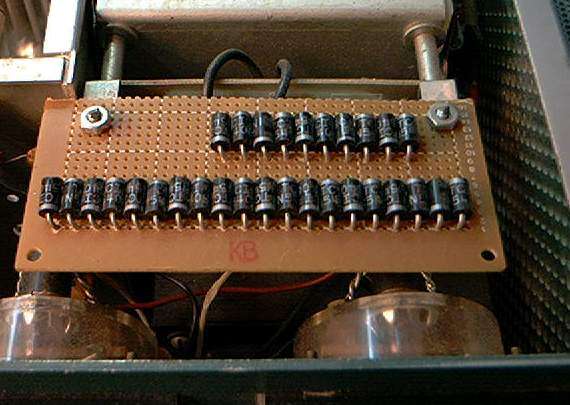
You can just build your own. No secret sauce to wiring thirty 3-Amp rectifier diodes in series. The good news is the voltage rating. That number tells you how many Volts of reverse (turned-off) voltage a diode can handle before it breaks down. You can use the ultra-cheap 50-Volt version, the 1N5400. The diodes will ALWAYS be forward-biased, showing about 2/3 of a Volt per diode. Reverse-voltage rating is irrelevant for diodes that will never have that reverse voltage applied to them. These won't. The regulation of the bias voltage is not quite as tight as the zener was, but plenty close enough to a 20-Volt zener diode. But with about a 20-Watt effective rating. And zeners are famously sensitive to surge damage. Rectifier diodes are a lot more robust in this department.
Or, you could just buy a commercially-made bias board that comes with brackets to mount it behind the meters.
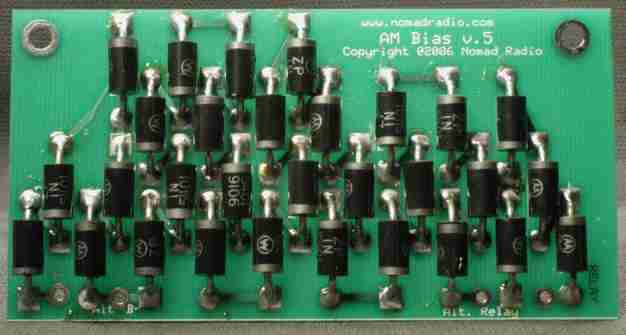
The 10-meter input circuit in the SB220 is pretty flimsy. Okay for 100-Watt peak sideband, but a problem for AM. You can't easily reach the tuning slug to re-peak for 11 meters. And the drive level people try to use on AM just roaches the stock 10-meter coil and capacitors. The easy solution most folks go for it to just cut the coax from the input side of the relay where it goes to the input side of the band selector. The coax gets run directly from the relay to the tubes' cathode circuit.
This eliminates the wimpy-coil problem, but creates a new one. Your driver is now feeding into a 3-to-1 SWR. The amplifier's input impedance with direct drive will be about 150 ohms. This reduces the power you can get into the tubes. Just the same as a high SWR reduces the power you can pump into an antenna.
Most books about grounded-grid amplifier design will mention that a tuned-input circuit works best the closer it is to the tube sockets. Heathkit chose to locate their input circuits on the other end of a 12-inch long piece of coax so they could mount it in a convenient spot. A perfectly-decent compromise, but a compromise.
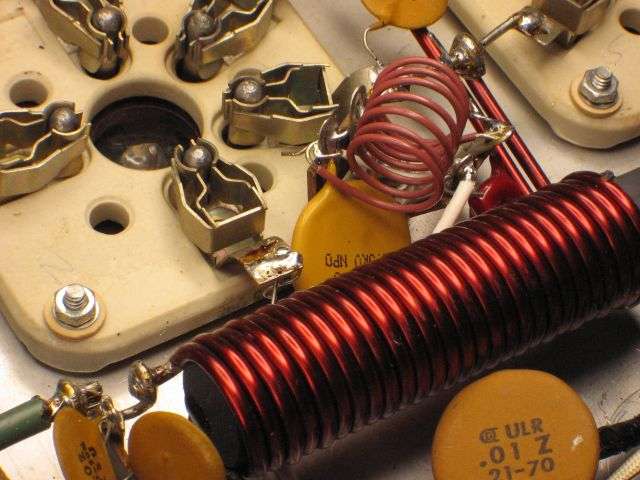
This simple setup does require a couple of one-terminal tie strips like the one already found on the inboard tube socket. This setup has a 68pf disc cap to gorund fom where the coax feeds from the relay, into a 7-turn coil wound on a half-inch form. The other end of the coil connects directly to on side of the tubes' cathodes. A 47pf disc cap goes to ground from there, also. The coil gets fine-tuned by squeezing or stretching the turns for lowest input-side SWR with carrier drive. Should get it down to 1.3 or better.
To make room for this mess, the original fat .01uf disc cap C32 gets moved. It was strung from the single tie point where the coax feeds the tubes, to the tube cathodes.
It gets mounted on the other 1-lug tie strip, between the relay and the input coax.
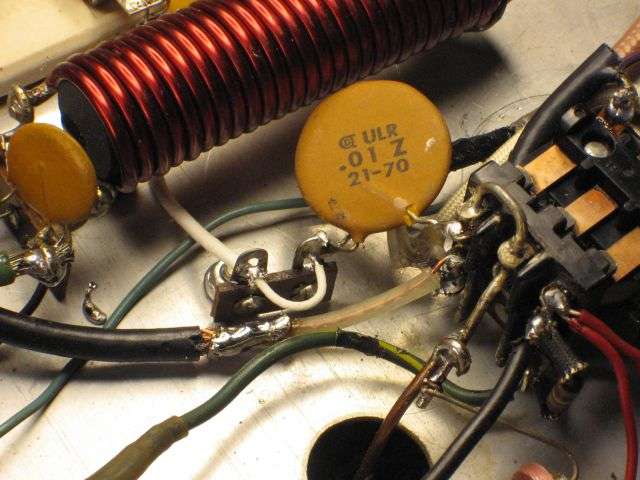
So long as you use disc caps rated for 2000 Volts or (better) more, this input-matching circuit will take whatever you throw at it. Won't make the amplifier one bit bigger, but just moves the weak link in the chain elsewhere.
This post has already gotten way out of hand. There are other measures to adapt the SB220 to high-power AM, but those are the highlights.
Maybe it's time for a more-detailed "how-to" post adapting the SB220 for heavy-duty AM service.
But it can be done. Just don't expect the factory-stock SSB-oriented setup to withstand 11-meter AM service. Things will break.
73
This was an excellent post nomadd. Even I understood it (LoL.)
A truly terrific post that only solidifies my belief that you are an amplifier God. Thanks for taking the time to share your knowledge. It's truly a shame you no longer take mail ins. I've finally come to the conclusion that the (sweep) tube amps I use are not for those like myself. One's who can't work on them should stay away from them. There's just no longer enough qualified persons willing to work on them any longer. At least not enough of them who truly know what they're doing. And even the ones that do don't seem to want to bother any longer. Not that transistorized amplifiers don't occur issues. Because as we all know they do (just like any Electronics gear.) But there are more qualified people who are not only willing to work on them but do take mail ins. Unless my continuing research changes my mind I'm, going to go with the Texas Star 500v's. One for my AM station, and one for the SSB setup. I live in South Jersy, and have been lucky enough to have a friend of a very well know local builder offer to bring the two amps I own that are in need of repair to him. Which I will be doing. Solely due to the fact that I've owned them so long and I'm finding it difficult to Let them Sit rotting away in a closet in paperweight condition. It's a nostalgic thing for me. And the good friend I recivred them from is no longer with us. I feel obligated to take care of what he enjoyed using immensely. And was nice enough to give to me during his later year's. I will on ocaoccas remove them from the closet and put them on the air but i'm done using them as every day users. As I mentioned I'm going to purchase two 500v's as i'm truly tired of having to deal with amps that although were refurbished to what I believe was a high quality refurb were, designed, and built when sweep tubes were 3-$6 each (just one reason. Many more for sure). I'm only having the issues addressed because of the offer to have the person i alluded to doing the repairs. No shipping is a good enough reason on it's own. 8950's selling for $60-$90 (!!!!) each is insane. And I'd have to be rich or stupid to purchase them if needed. Buying two 500z-g's or a couple of 250b's makes sense if those are what ones amp uses. But sweep tube prices are totally out of control! For a partial retube of 6lq6's, 6lf6, 6kv6, 8950 ect ect amp one could purchase a brand new 500v. Which has a good build quality, (from what I've read so far) and if driven properly will show 4-500 watts respectively, and should be enjoyed for many years trubble free. Sorry for getting off your op's subject. 73's ps. Once again thanks for an excellent post.
ButtFuzz
Anti-BS Advocate ● WO0WOO ● Reverend Doctor
Absolutely AGREE! The amp must be connected to the antenna BEFORE drive is applied...and then drive removed before amp switches back....otherwise the "HOT" switching of the amp relays occurs.
I won't even use RF switching even if the amp has that provision...I use a direct connection from PTT circuit...Screw the SSB/CW delay...ASKING for FAILURE...
All the Best
Gary
I have a little red button on the worksurface marked "WorldWide"!
What PF cap can I put on the input to get the pass though match down and what PF to add to the 10m coil to get a better swr?
I turned the slug a couple threads out of the cardboard cylinder and I have a 1.6.
Will the input SWR equal the antenna SWR?
Like if I have a 1.5 will the input SWR be 1.5 too no matter what?
thanks
I turned the slug a couple threads out of the cardboard cylinder and I have a 1.6.
Will the input SWR equal the antenna SWR?
Like if I have a 1.5 will the input SWR be 1.5 too no matter what?
thanks
Ah, the first thing to wonder about is that input coil being resonant. The two silver-mica capacitors, plus the capacitance inside the tube are what make the circuit resonate along with the coil's slug position.
An antenna analyzer is where I would start. If the coil will only tune to a frequency above 27 MHz, you need to add capacitance. A resonant frequency below calls for less capacitance. This doesn't tell you which of the two capacitors, or both need to change, or how much.
Does tell you which direction you need to go, up or down from 27 MHz.
I wish I had a sure-fire capacitance value to suggest for those two parts, but I don't.
The stock 10-meter input circuit is only good for about 150 Watt peaks, or 35 Watts average power. Hot-rodding on AM will usually damage them. Any time you see a SB220 or 221 that has the coax to and from the input side of the bandswitch clipped off short this is a bad sign. Feeding the tube sockets directly from the relay is bad policy, and will get you a 3-to-1 or worse mismatch.
Personally, I would call a 1.6 input match a win and move on to the next challenge. Improving it further won't accomplish much.
Making the SB220 into an AM hot rod to run on the SSB side calls for a few modifications. Bypassing the band selector is one of them. I had a pic of the 11-meter only input circuit for the monoband 11-meter fanatic's amplifier, but Imageshack has lost it.
Oops.
One other detail that improves this amplifier's lifespan running AM at full plate voltage is cathode bias. The 5-Volt 10-Watt zener diode sets the idle current through the tubes with no drive. This puts roughly half the tube's heat rating or more onto the tubes before you put any drive into it. The additional heat from an AM carrier will push them beyond the 500-Watt rating before you even say "Helloooo". Biasing the tubes near cutoff takes around 20 Volts, or a little more. Most efficient way to accomplish this is with a series string of thirty 3-Amp rectifier diodes. Unlike a zener, you turn them around so they conduct forward current. at 2/3 of a Volt each, it takes thirty of them. The advantage is that they are a lot tougher than any zener diode. Brief surges are less likely to damage them. The original zener diode is fine for sideband, but sooner or later AM will overheat it. When this happens, that 5-Volt zener becomes a zero-volt zener. The only hint that this has happened will be a higher idle current. The tubes will now throw up to about 400 Watts of heat apiece no-drive with zero bias on them.
The only hint until the heat makes the solder melt and dribble from the tubes' two cathode pins.
Here's one way to do it.
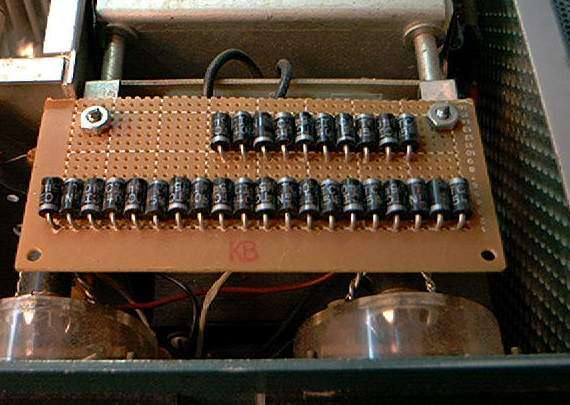
20 Volts doesn't quite cut off the tube's zero-drive current altogether. Does hold the zero-drive heat on each tube down to 50 or 60 Watts each, more or less. Does bring down the heat to a safe level for AM with the "SSB" high side selected.
It also messes with the input impedance of the tubes, so that input match tends to change when this is done. Whether it would make the match to the stock input coil better or worse I can't say.
And if you plan to use it mostly for sideband, or on low side for AM, leave it alone where it is.
1.6 still sounds like a "win" to me.
73
An antenna analyzer is where I would start. If the coil will only tune to a frequency above 27 MHz, you need to add capacitance. A resonant frequency below calls for less capacitance. This doesn't tell you which of the two capacitors, or both need to change, or how much.
Does tell you which direction you need to go, up or down from 27 MHz.
I wish I had a sure-fire capacitance value to suggest for those two parts, but I don't.
The stock 10-meter input circuit is only good for about 150 Watt peaks, or 35 Watts average power. Hot-rodding on AM will usually damage them. Any time you see a SB220 or 221 that has the coax to and from the input side of the bandswitch clipped off short this is a bad sign. Feeding the tube sockets directly from the relay is bad policy, and will get you a 3-to-1 or worse mismatch.
Personally, I would call a 1.6 input match a win and move on to the next challenge. Improving it further won't accomplish much.
Making the SB220 into an AM hot rod to run on the SSB side calls for a few modifications. Bypassing the band selector is one of them. I had a pic of the 11-meter only input circuit for the monoband 11-meter fanatic's amplifier, but Imageshack has lost it.
Oops.
One other detail that improves this amplifier's lifespan running AM at full plate voltage is cathode bias. The 5-Volt 10-Watt zener diode sets the idle current through the tubes with no drive. This puts roughly half the tube's heat rating or more onto the tubes before you put any drive into it. The additional heat from an AM carrier will push them beyond the 500-Watt rating before you even say "Helloooo". Biasing the tubes near cutoff takes around 20 Volts, or a little more. Most efficient way to accomplish this is with a series string of thirty 3-Amp rectifier diodes. Unlike a zener, you turn them around so they conduct forward current. at 2/3 of a Volt each, it takes thirty of them. The advantage is that they are a lot tougher than any zener diode. Brief surges are less likely to damage them. The original zener diode is fine for sideband, but sooner or later AM will overheat it. When this happens, that 5-Volt zener becomes a zero-volt zener. The only hint that this has happened will be a higher idle current. The tubes will now throw up to about 400 Watts of heat apiece no-drive with zero bias on them.
The only hint until the heat makes the solder melt and dribble from the tubes' two cathode pins.
Here's one way to do it.

20 Volts doesn't quite cut off the tube's zero-drive current altogether. Does hold the zero-drive heat on each tube down to 50 or 60 Watts each, more or less. Does bring down the heat to a safe level for AM with the "SSB" high side selected.
It also messes with the input impedance of the tubes, so that input match tends to change when this is done. Whether it would make the match to the stock input coil better or worse I can't say.
And if you plan to use it mostly for sideband, or on low side for AM, leave it alone where it is.
1.6 still sounds like a "win" to me.
73
I had a pic of the 11-meter only input circuit for the monoband 11-meter fanatic's amplifier, but Imageshack has lost it.
this?
Ya imageshack is a bunch of jagoffs for sure they screwed me too after years on there. I was able to retrieve all my images before it was too late thank goodness.
I just want to put the pro3 into it, maybe 110w pep SSB only.
The pro 3 is super picky and folds back at 1.4. At 1.6 its only 82w unless I scream or whistle. Its not as good as my 765 or 735 were for avg talk power at all.
With the amp off I get 62w because its 2:1 swr, I use the built in tuner but the tuner soaks up about 25w for some reason.
If I put the tuner on the SB220 starts to sing, almost 1400+. I didn't push for max but I could see it liked it.
I have a acom 1000 and while its easier to tune, has a flat swr, it does not have the audio quality that the heathkit does and to be honest I think the SB220 is cleaner too.
I have a mfj, and I heard rumor that you can ground the cathode with a resistor and key the relay by hand and tune but couldn't find the particulars.
I had one recently I had to convert. It was beat up bad. Ended up mono banding it. I ran a high Q input in hopes of cutting down harmonics and hopefully prolonging the life of the parasitic chokes. Had about 660pf of total capacitance on input Pi. Lol. Bandswitch was smoked completely. Pulled the load cap out. Used the Tune cap as load capacitor and padded with a 100pf doorknob. Then used a 4500v capacitor for load. Worked good. Already had Harbach board so amp idled at around 90mA.
If I wanted to mono band I would need an isolated variable cap like the others in there already right not one that goes to the case of the tunable cap like something out of a d&a amp to hook the input off the broken band switch out out put through.
